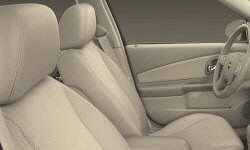An increasing amount of attention is being focused on whiplash protection, and as a result manufacturers have been designing headrests that offer better protection when the car is rear-ended. This is a good thing, right? Well, not entirely. In some cases a safer headrest can be very uncomfortable.
To make the headrest safer, the manufacturer positions it further forward, sometimes so far forward that those with relatively vertical necks (like mine) find that they cannot hold their head where they normally would. Instead, their head is pressed forward.
 I first encountered this issue when test driving the 2004 Chevrolet Malibu. I ended up removing the headrest and re-inserting it backwards. While this made sitting in the car far more bearable, no doubt safety was compromised. Since then I’ve read of similar problems with other cars.
I first encountered this issue when test driving the 2004 Chevrolet Malibu. I ended up removing the headrest and re-inserting it backwards. While this made sitting in the car far more bearable, no doubt safety was compromised. Since then I’ve read of similar problems with other cars.
To avoid buying a car you cannot then stand to drive, pay attention to the location of the headrest during the test drive. You might also want to try to passenger seat in a reclined position, if it is likely to be used this way on long trips.
How can this problem be avoided without compromising safety? Through “active headrests” that move forward automatically when the car is rear-ended. These work by connecting the headrest to a plate inside the seatback, with a pivot point on the rod that connects them. When a rear-end collision forces the driver’s body into the seatback, the pressure on the plate transfers through the lever to press the headrest forward. TrueDelta tracks this feature. So if you compare two cars and one has this feature while the other does not, you’ll find it in the results.